Note
Go to the end to download the full example code.
Comparing spectral connectivity computed over time or over trials#
This example demonstrates the difference between spectral connectivity computed over time or over trials.
A brief background on the difference between the two conditions is provided, followed by examples on simulated data and real EEG data.
Background#
Spectral connectivity is a method for inferring the relationship between channels decomposed at different frequencies of interest. The channels could be M/EEG sensors or brain regions estimated with source localization.
There are multiple different spectral connectivity measures, e.g. coherence, imaginary part of coherence, phase locking value, and envelope correlations. Additionally, there are also multiple methods to estimate the frequency content, e.g. Fourier transforms, Morlet wavelets and multitapers.
In this example, we focus on the two functions, which both computes
connectivity from epoched data mne.Epochs:
mne_connectivity.spectral_connectivity_epochs() and
mne_connectivity.spectral_connectivity_time().
Both functions contain the options to choose the connectivity measurements of interest and the method to decompose the frequency content. The crucial difference between when to use which function lies on the experimental setup and type of tasks.
If the data is obtained for repeated trials of a time-locked event,
e.g. ERP data, then
mne_connectivity.spectral_connectivity_epochs()
is most likely the corresponding function to utilize.
If the data is obtained from resting-state or free-moving tasks,
e.g. a mirror-game paradigm [1], then
mne_connectivity.spectral_connectivity_time() might be better suited.
Assumptions and Interpretations
The way connectivity is computed for the two functions are slightly different, thus their interpretations and the hypotheses being tested are also different.
Connectivity over trials, as computed by
mne_connectivity.spectral_connectivity_epochs() assume epochs have
been created around each trial and the function estimates the connectivity
at each timepoint over all the repeated trials for the same event.
This gives a high temporal resolution, which is often desired for ERP
analysis where you are interested in when an effect occurs.
However, this approach is not feasible for single-trial data and will
result in errorful values when computed on one epoch.
On the other hand, if you are interested in determining connectivity over
time for single-trials or from experiments that do not involve exactly
repeated trials, then mne_connectivity.spectral_connectivity_time()
should be employed. This function also takes data in the form of
mne.Epochs, but it may consist of a single epoch.
If there are multiple epochs, the connectivity over time is computed for
epoch separately, with the option to average over epochs.
To better illustrate the differences and usages for the two functions, we will employ them on two simulated cases and also analyze a real visual task dataset.
# Author: Qianliang Li <glia@dtu.dk>
#
# License: BSD (3-clause)
import matplotlib.pyplot as plt
import mne
import numpy as np
from mne.datasets import sample
from mne_connectivity import spectral_connectivity_epochs, spectral_connectivity_time
from mne_connectivity.viz import plot_sensors_connectivity
rng = np.random.default_rng(1234) # set seed for reproducibility
print(__doc__)
Simulated examples#
Case 1: Repetitions of the same trial.
Let’s generate some simulated data in the format of mne.EpochsArray.
In this case, we will use random data for 3 channels over 5 epochs, but
all the epochs are just exact replicates of the first epoch. This simulates
when data is collected over an event of interest where we assume the
connectivity structure is the same over each event.
n_epochs = 5 # number of simulated epochs
n_channels = 3 # number of channels
n_times = 2000 # number of sample points
sfreq = 250 # Set sampling freq
data = rng.random((n_epochs, n_channels, n_times)) # generate random data
# In case 1, we overwrite all epochs with the data from the first epoch
for i in range(n_epochs):
data[i] = data[0]
ch_names = ["C3", "Cz", "C4"] # three random channel names
info = mne.create_info(ch_names, sfreq, ch_types="eeg") # create info object
data_epoch = mne.EpochsArray(data, info) # create EpochsArray
data_epoch.plot(scalings=0.75) # Visualize the data
Not setting metadata
5 matching events found
No baseline correction applied
0 projection items activated
Using qt as 2D backend.
<mne_qt_browser._pg_figure.MNEQtBrowser object at 0x70bfb40ccaf0>
First we compute connectivity over trials.
# Freq bands of interest
Freq_Bands = {"theta": [4.0, 8.0], "alpha": [8.0, 13.0], "beta": [13.0, 30.0]}
n_freq_bands = len(Freq_Bands)
min_freq = np.min(list(Freq_Bands.values()))
max_freq = np.max(list(Freq_Bands.values()))
# Provide the freq points
freqs = np.linspace(min_freq, max_freq, int((max_freq - min_freq) * 4 + 1))
# The dictionary with frequencies are converted to tuples for the function
fmin = tuple([list(Freq_Bands.values())[f][0] for f in range(len(Freq_Bands))])
fmax = tuple([list(Freq_Bands.values())[f][1] for f in range(len(Freq_Bands))])
# We will try two different connectivity measurements as an example
connectivity_methods = ["coh", "plv"]
n_con_methods = len(connectivity_methods)
# Pre-allocatate memory for the connectivity matrices
con_epochs_array = np.zeros(
(n_con_methods, n_channels, n_channels, n_freq_bands, n_times)
)
con_epochs_array[con_epochs_array == 0] = np.nan # nan matrix
# Compute connectivity over trials
con_epochs = spectral_connectivity_epochs(
data_epoch,
method=connectivity_methods,
sfreq=sfreq,
mode="cwt_morlet",
cwt_freqs=freqs,
fmin=fmin,
fmax=fmax,
faverage=True,
)
# Get data as connectivity matrices
for c in range(n_con_methods):
con_epochs_array[c] = con_epochs[c].get_data(output="dense")
/home/circleci/project/mne_connectivity/spectral/epochs.py:1194: RuntimeWarning: There were no Annotations stored in <EpochsArray | 5 events (all good), 0 – 7.996 s (baseline off), ~241 KiB, data loaded,
'1': 5>, so metadata was not modified.
data.add_annotations_to_metadata(overwrite=True)
Connectivity computation...
using t=0.000s..7.996s for estimation (2000 points)
computing connectivity for the bands:
band 1: 4.0Hz..8.0Hz (17 points)
band 2: 8.0Hz..13.0Hz (21 points)
band 3: 13.0Hz..30.0Hz (69 points)
connectivity scores will be averaged for each band
only using indices for lower-triangular matrix
computing connectivity for 3 connections
using CWT with Morlet wavelets to estimate spectra
the following metrics will be computed: Coherence, PLV
computing cross-spectral density for epoch 1
computing cross-spectral density for epoch 2
computing cross-spectral density for epoch 3
computing cross-spectral density for epoch 4
computing cross-spectral density for epoch 5
assembling connectivity matrix
[Connectivity computation done]
As previously mentioned, connectivity over trials can give connectivity
for each timepoint, here in the form of
mne_connectivity.SpectroTemporalConnectivity.
However, in this example we are not interested in the timing, so we will
average over all timepoints. Notice that only mode="cwt_morlet" will
return an instance of mne_connectivity.SpectroTemporalConnectivity
and mode="fourier" or mode="multitaper" returns an instance of
mne_connectivity.SpectralConnectivity, which does not have
single timepoint resolution.
con_epochs_array = np.mean(con_epochs_array, axis=4) # average over timepoints
# In this example, we will just show alpha
foi = list(Freq_Bands.keys()).index("alpha") # frequency of interest
# Define function for plotting con matrices
def plot_con_matrix(con_data, n_con_methods):
"""Visualize the connectivity matrix."""
fig, ax = plt.subplots(1, n_con_methods, figsize=(6 * n_con_methods, 6))
for c in range(n_con_methods):
# Plot with imshow
con_plot = ax[c].imshow(con_data[c, :, :, foi], cmap="binary", vmin=0, vmax=1)
# Set title
ax[c].set_title(connectivity_methods[c])
# Add colorbar
fig.colorbar(con_plot, ax=ax[c], shrink=0.7, label="Connectivity")
# Fix labels
ax[c].set_xticks(range(len(ch_names)))
ax[c].set_xticklabels(ch_names)
ax[c].set_yticks(range(len(ch_names)))
ax[c].set_yticklabels(ch_names)
print(
f"Connectivity method: {connectivity_methods[c]}\n"
+ f"{con_data[c,:,:,foi]}"
)
return fig
plot_con_matrix(con_epochs_array, n_con_methods)
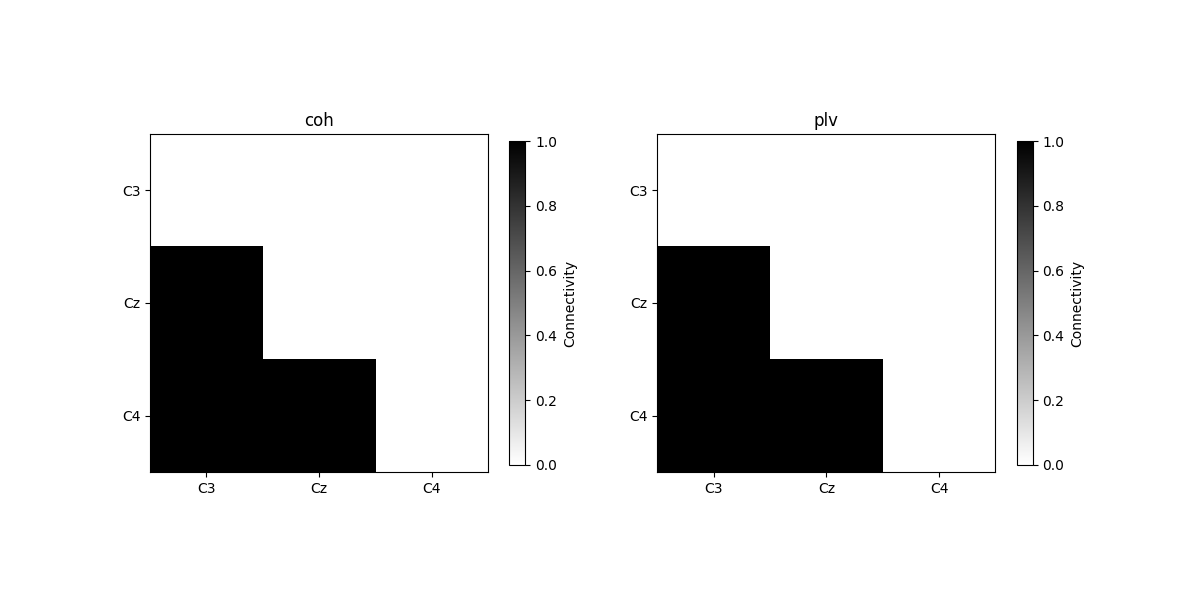
Connectivity method: coh
[[0. 0. 0.]
[1. 0. 0.]
[1. 1. 0.]]
Connectivity method: plv
[[0. 0. 0.]
[1. 0. 0.]
[1. 1. 0.]]
<Figure size 1200x600 with 4 Axes>
We see that when using repeated trials without any noise, the phase coupling between the three electrodes over trials are exactly 1.
We will now compute connectivity over time.
# Pre-allocatate memory for the connectivity matrices
con_time_array = np.zeros(
(n_con_methods, n_epochs, n_channels, n_channels, n_freq_bands)
)
con_time_array[con_time_array == 0] = np.nan # nan matrix
# Compute connectivity over time
con_time = spectral_connectivity_time(
data_epoch,
freqs,
method=connectivity_methods,
sfreq=sfreq,
mode="cwt_morlet",
fmin=fmin,
fmax=fmax,
faverage=True,
)
# Get data as connectivity matrices
for c in range(n_con_methods):
con_time_array[c] = con_time[c].get_data(output="dense")
/home/circleci/project/mne_connectivity/spectral/time.py:420: RuntimeWarning: There were no Annotations stored in <EpochsArray | 5 events (all good), 0 – 7.996 s (baseline off), ~241 KiB, data loaded,
'1': 5>, so metadata was not modified.
data.add_annotations_to_metadata(overwrite=True)
only using indices for lower-triangular matrix
Connectivity computation...
Processing epoch 1 / 5 ...
Processing epoch 2 / 5 ...
Processing epoch 3 / 5 ...
Processing epoch 4 / 5 ...
Processing epoch 5 / 5 ...
[Connectivity computation done]
Notice that the connectivity over time function by default gives connectivity
for each epoch. We will average over epochs to show similar matrices as
before, but it could also be done in the function itself by setting
average=True.
con_time_array = np.mean(con_time_array, axis=1) # average over epochs
foi = list(Freq_Bands.keys()).index("alpha") # frequency of interest
plot_con_matrix(con_time_array, n_con_methods)
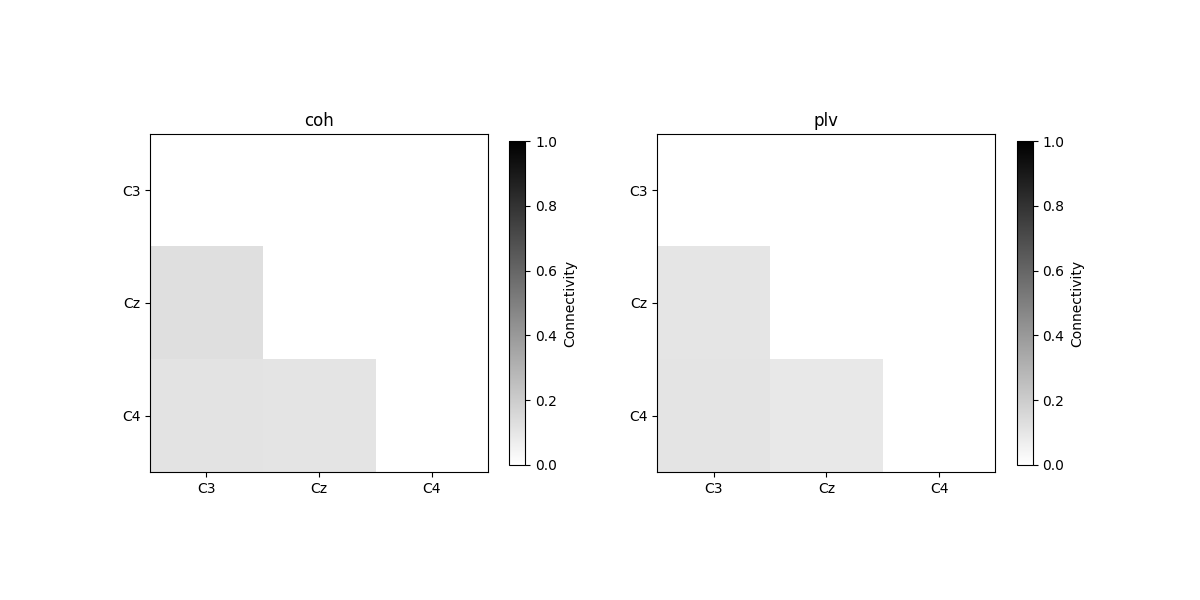
Connectivity method: coh
[[0. 0. 0. ]
[0.12731767 0. 0. ]
[0.10982631 0.10808101 0. ]]
Connectivity method: plv
[[0. 0. 0. ]
[0.1021756 0. 0. ]
[0.10768869 0.09365795 0. ]]
<Figure size 1200x600 with 4 Axes>
We see that the connectivity over time are not 1, since the signals were randomly generated and therefore the phase differences between channels are also random over time.
Case 2: 10 Hz sinus waves with different phases.
In this case, we will generate 10 Hz sinus waves with different phases for each epoch and each channel. In this case we would expect the connectivity over time between channels to be 1, but not the connectivity over trials.
for i in range(n_epochs): # ensure each epoch are different
for c in range(n_channels): # and each channel are also different
wave_freq = 10 # freq of the sinus wave
epoch_len = n_times / sfreq
phase = rng.random(1) * 10 # Introduce random phase for each channel
# Generate sinus wave
x = np.linspace(
-wave_freq * epoch_len * np.pi + phase,
wave_freq * epoch_len * np.pi + phase,
n_times,
)
data[i, c] = np.squeeze(np.sin(x)) # overwrite to data
data_epoch = mne.EpochsArray(data, info) # create EpochsArray
# Visualize one epoch to see the phase differences
data_epoch.plot(scalings=1, n_epochs=1)
Not setting metadata
5 matching events found
No baseline correction applied
0 projection items activated
<mne_qt_browser._pg_figure.MNEQtBrowser object at 0x70bfac5fe210>
First we compute connectivity over trials.
# Pre-allocatate memory for the connectivity matrices
con_epochs_array = np.zeros(
(n_con_methods, n_channels, n_channels, n_freq_bands, n_times)
)
con_epochs_array[con_epochs_array == 0] = np.nan # nan matrix
# Compute connecitivty over trials
con_epochs = spectral_connectivity_epochs(
data_epoch,
method=connectivity_methods,
sfreq=sfreq,
mode="cwt_morlet",
cwt_freqs=freqs,
fmin=fmin,
fmax=fmax,
faverage=True,
)
# Get data as connectivity matrices
for c in range(n_con_methods):
con_epochs_array[c] = con_epochs[c].get_data(output="dense")
con_epochs_array = np.mean(con_epochs_array, axis=4) # average over timepoints
foi = list(Freq_Bands.keys()).index("alpha") # frequency of interest
plot_con_matrix(con_epochs_array, n_con_methods)
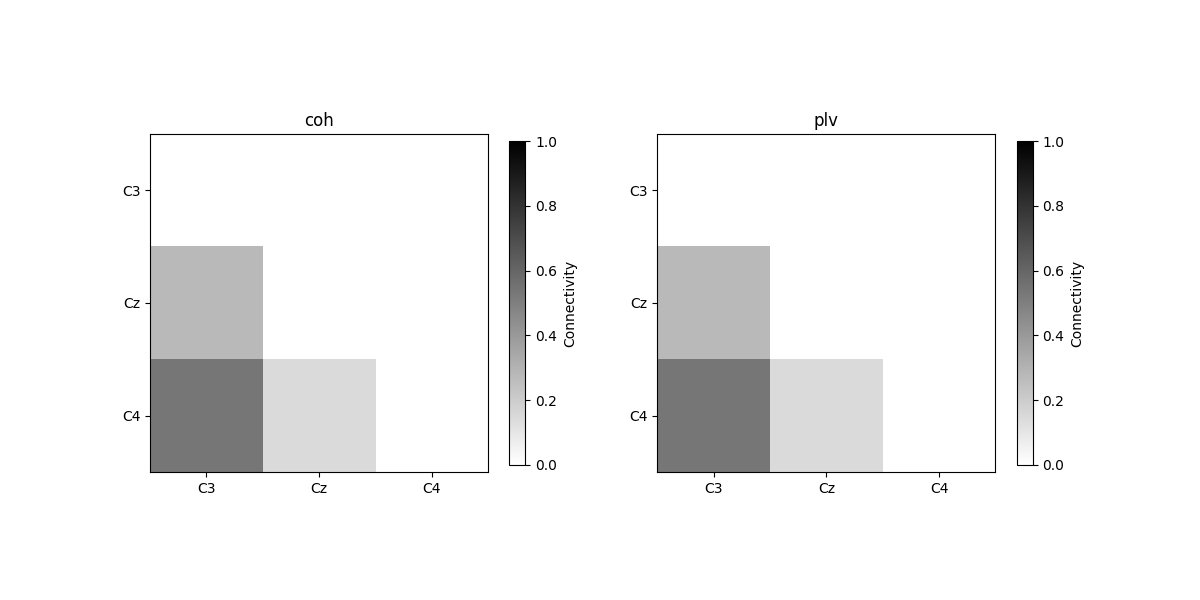
/home/circleci/project/mne_connectivity/spectral/epochs.py:1194: RuntimeWarning: There were no Annotations stored in <EpochsArray | 5 events (all good), 0 – 7.996 s (baseline off), ~241 KiB, data loaded,
'1': 5>, so metadata was not modified.
data.add_annotations_to_metadata(overwrite=True)
Connectivity computation...
using t=0.000s..7.996s for estimation (2000 points)
computing connectivity for the bands:
band 1: 4.0Hz..8.0Hz (17 points)
band 2: 8.0Hz..13.0Hz (21 points)
band 3: 13.0Hz..30.0Hz (69 points)
connectivity scores will be averaged for each band
only using indices for lower-triangular matrix
computing connectivity for 3 connections
using CWT with Morlet wavelets to estimate spectra
the following metrics will be computed: Coherence, PLV
computing cross-spectral density for epoch 1
computing cross-spectral density for epoch 2
computing cross-spectral density for epoch 3
computing cross-spectral density for epoch 4
computing cross-spectral density for epoch 5
assembling connectivity matrix
[Connectivity computation done]
Connectivity method: coh
[[0. 0. 0. ]
[0.27435408 0. 0. ]
[0.53746866 0.14499043 0. ]]
Connectivity method: plv
[[0. 0. 0. ]
[0.27426325 0. 0. ]
[0.53762563 0.14508685 0. ]]
<Figure size 1200x600 with 4 Axes>
We see that connectivity over trials are not 1, since the phase differences between two channels are not the same over trials.
We will now compute connectivity over time.
# Pre-allocatate memory for the connectivity matrices
con_time_array = np.zeros(
(n_con_methods, n_epochs, n_channels, n_channels, n_freq_bands)
)
con_time_array[con_time_array == 0] = np.nan # nan matrix
con_time = spectral_connectivity_time(
data_epoch,
freqs,
method=connectivity_methods,
sfreq=sfreq,
fmin=fmin,
fmax=fmax,
faverage=True,
)
# Get data as connectivity matrices
for c in range(n_con_methods):
con_time_array[c] = con_time[c].get_data(output="dense")
con_time_array = np.mean(con_time_array, axis=1) # average over epochs
foi = list(Freq_Bands.keys()).index("alpha") # frequency of interest
plot_con_matrix(con_time_array, n_con_methods)
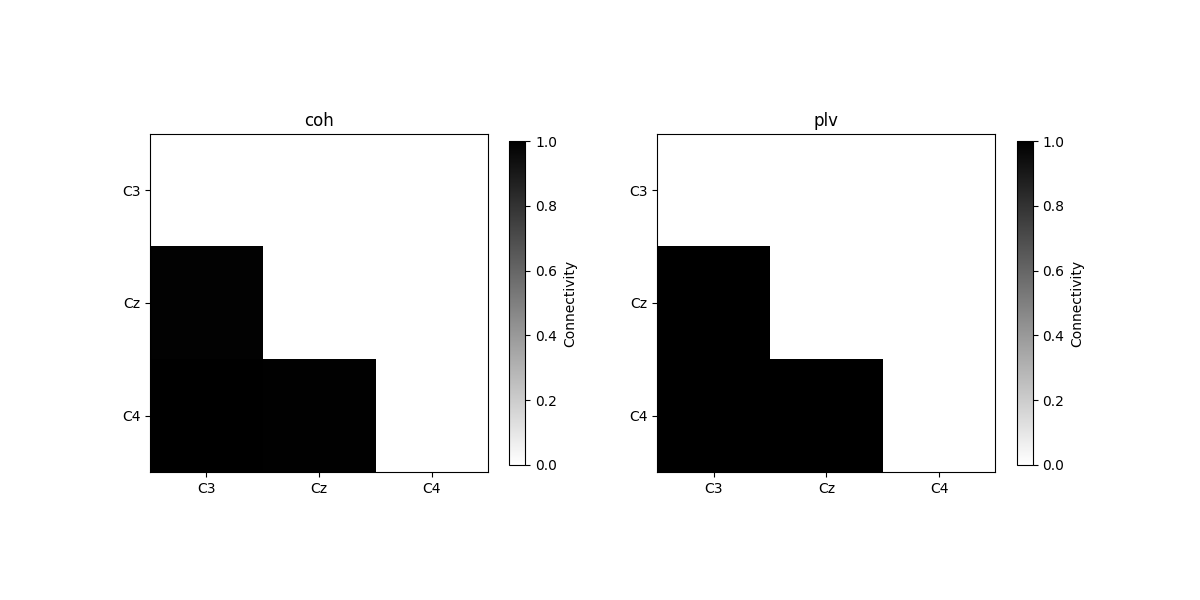
/home/circleci/project/mne_connectivity/spectral/time.py:420: RuntimeWarning: There were no Annotations stored in <EpochsArray | 5 events (all good), 0 – 7.996 s (baseline off), ~241 KiB, data loaded,
'1': 5>, so metadata was not modified.
data.add_annotations_to_metadata(overwrite=True)
only using indices for lower-triangular matrix
Connectivity computation...
Processing epoch 1 / 5 ...
Processing epoch 2 / 5 ...
Processing epoch 3 / 5 ...
Processing epoch 4 / 5 ...
Processing epoch 5 / 5 ...
[Connectivity computation done]
Connectivity method: coh
[[0. 0. 0. ]
[0.98702769 0. 0. ]
[0.99566697 0.9918241 0. ]]
Connectivity method: plv
[[0. 0. 0. ]
[0.99795261 0. 0. ]
[0.99918175 0.99879001 0. ]]
<Figure size 1200x600 with 4 Axes>
We see that for case 2, the connectivity over time is approximately 1, since the phase differences over time between two channels are synchronized.
Real data demonstration#
To finish this example, we will compute connectivity for a sample EEG data.
data_path = sample.data_path()
raw_fname = data_path / "MEG/sample/sample_audvis_filt-0-40_raw.fif"
event_fname = data_path / "MEG/sample/sample_audvis_filt-0-40_raw-eve.fif"
raw = mne.io.read_raw_fif(raw_fname)
events = mne.read_events(event_fname)
# Select only the EEG
picks = mne.pick_types(
raw.info, meg=False, eeg=True, stim=False, eog=False, exclude="bads"
)
# Create epochs for left visual field stimulus
event_id, tmin, tmax = 3, -0.3, 1.6
epochs = mne.Epochs(raw, events, event_id, tmin, tmax, picks=picks, baseline=(None, 0))
epochs.load_data() # load the data
Opening raw data file /home/circleci/mne_data/MNE-sample-data/MEG/sample/sample_audvis_filt-0-40_raw.fif...
Read a total of 4 projection items:
PCA-v1 (1 x 102) idle
PCA-v2 (1 x 102) idle
PCA-v3 (1 x 102) idle
Average EEG reference (1 x 60) idle
Range : 6450 ... 48149 = 42.956 ... 320.665 secs
Ready.
Not setting metadata
73 matching events found
Setting baseline interval to [-0.2996928197375818, 0.0] s
Applying baseline correction (mode: mean)
Created an SSP operator (subspace dimension = 1)
1 projection items activated
Loading data for 73 events and 286 original time points ...
0 bad epochs dropped
The sample data consist of repeated trials with a visual stimuli,
thus we use mne_connectivity.spectral_connectivity_epochs()
to compute connectivity over trials.
Visual tasks are known for evoking event related P1 and N1 responses, which occurs around 100 and 170 ms after stimuli presentation in posterior sites. Additionally, increased theta and alpha phase locking have also been observed during the time window of P1 and N1 [2]. Here, we will therefore analyze phase connectivity in the theta band around P1
sfreq = epochs.info["sfreq"] # the sampling frequency
tmin = 0.0 # exclude the baseline period for connectivity estimation
Freq_Bands = {"theta": [4.0, 8.0]} # frequency of interest
n_freq_bands = len(Freq_Bands)
min_freq = np.min(list(Freq_Bands.values()))
max_freq = np.max(list(Freq_Bands.values()))
# Prepare the freq points
freqs = np.linspace(min_freq, max_freq, int((max_freq - min_freq) * 4 + 1))
fmin = tuple([list(Freq_Bands.values())[f][0] for f in range(len(Freq_Bands))])
fmax = tuple([list(Freq_Bands.values())[f][1] for f in range(len(Freq_Bands))])
# We specify the connectivity measurements
connectivity_methods = ["wpli"]
n_con_methods = len(connectivity_methods)
# Compute connectivity over trials
con_epochs = spectral_connectivity_epochs(
epochs,
method=connectivity_methods,
sfreq=sfreq,
mode="cwt_morlet",
cwt_freqs=freqs,
fmin=fmin,
fmax=fmax,
faverage=True,
tmin=tmin,
cwt_n_cycles=4,
)
Adding metadata with 3 columns
Connectivity computation...
using t=0.000s..1.598s for estimation (241 points)
frequencies: 4.0Hz..8.0Hz (17 points)
connectivity scores will be averaged for each band
only using indices for lower-triangular matrix
computing connectivity for 1711 connections
using CWT with Morlet wavelets to estimate spectra
the following metrics will be computed: WPLI
computing cross-spectral density for epoch 1
computing cross-spectral density for epoch 2
computing cross-spectral density for epoch 3
computing cross-spectral density for epoch 4
computing cross-spectral density for epoch 5
computing cross-spectral density for epoch 6
computing cross-spectral density for epoch 7
computing cross-spectral density for epoch 8
computing cross-spectral density for epoch 9
computing cross-spectral density for epoch 10
computing cross-spectral density for epoch 11
computing cross-spectral density for epoch 12
computing cross-spectral density for epoch 13
computing cross-spectral density for epoch 14
computing cross-spectral density for epoch 15
computing cross-spectral density for epoch 16
computing cross-spectral density for epoch 17
computing cross-spectral density for epoch 18
computing cross-spectral density for epoch 19
computing cross-spectral density for epoch 20
computing cross-spectral density for epoch 21
computing cross-spectral density for epoch 22
computing cross-spectral density for epoch 23
computing cross-spectral density for epoch 24
computing cross-spectral density for epoch 25
computing cross-spectral density for epoch 26
computing cross-spectral density for epoch 27
computing cross-spectral density for epoch 28
computing cross-spectral density for epoch 29
computing cross-spectral density for epoch 30
computing cross-spectral density for epoch 31
computing cross-spectral density for epoch 32
computing cross-spectral density for epoch 33
computing cross-spectral density for epoch 34
computing cross-spectral density for epoch 35
computing cross-spectral density for epoch 36
computing cross-spectral density for epoch 37
computing cross-spectral density for epoch 38
computing cross-spectral density for epoch 39
computing cross-spectral density for epoch 40
computing cross-spectral density for epoch 41
computing cross-spectral density for epoch 42
computing cross-spectral density for epoch 43
computing cross-spectral density for epoch 44
computing cross-spectral density for epoch 45
computing cross-spectral density for epoch 46
computing cross-spectral density for epoch 47
computing cross-spectral density for epoch 48
computing cross-spectral density for epoch 49
computing cross-spectral density for epoch 50
computing cross-spectral density for epoch 51
computing cross-spectral density for epoch 52
computing cross-spectral density for epoch 53
computing cross-spectral density for epoch 54
computing cross-spectral density for epoch 55
computing cross-spectral density for epoch 56
computing cross-spectral density for epoch 57
computing cross-spectral density for epoch 58
computing cross-spectral density for epoch 59
computing cross-spectral density for epoch 60
computing cross-spectral density for epoch 61
computing cross-spectral density for epoch 62
computing cross-spectral density for epoch 63
computing cross-spectral density for epoch 64
computing cross-spectral density for epoch 65
computing cross-spectral density for epoch 66
computing cross-spectral density for epoch 67
computing cross-spectral density for epoch 68
computing cross-spectral density for epoch 69
computing cross-spectral density for epoch 70
computing cross-spectral density for epoch 71
computing cross-spectral density for epoch 72
computing cross-spectral density for epoch 73
assembling connectivity matrix
[Connectivity computation done]
Notice we have shortened the wavelets to 4 cycles since we only have 1.6s epochs and are looking at theta activity. This might make the connectivity measurements more sensitive to noise.
# Plot the global connectivity over time
n_channels = epochs.info["nchan"] # get number of channels
times = epochs.times[epochs.times >= tmin] # get the timepoints
n_connections = (n_channels * n_channels - n_channels) / 2
# Get global avg connectivity over all connections
con_epochs_raveled_array = con_epochs.get_data(output="raveled")
global_con_epochs = np.sum(con_epochs_raveled_array, axis=0) / n_connections
# Since there is only one freq band, we choose the first dimension
global_con_epochs = global_con_epochs[0]
fig = plt.figure()
plt.plot(times, global_con_epochs)
plt.xlabel("Time (s)")
plt.ylabel("Global theta wPLI over trials")
# Get the timepoint with highest global connectivity right after stimulus
t_con_max = np.argmax(global_con_epochs[times <= 0.5])
print(f"Global theta wPLI peaks {times[t_con_max]:.3f}s after stimulus")
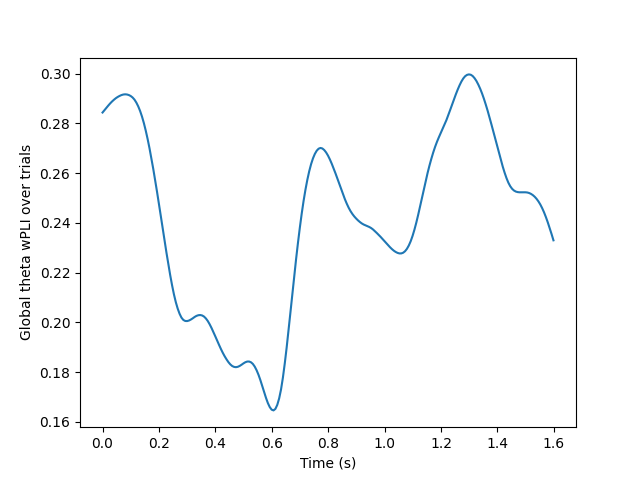
Global theta wPLI peaks 0.080s after stimulus
We see that around the timing of the P1 evoked response, there is high theta phase coupling on a global scale. To investigate in more details the individual channels, we visualize the connectivity matrix at the timepoint with most global theta connectivity after stimulus presentation and plot the sensor connectivity of the 20 highest connections
# Plot the connectivity matrix at the timepoint with highest global wPLI
con_epochs_matrix = con_epochs.get_data(output="dense")[:, :, 0, t_con_max]
fig = plt.figure()
im = plt.imshow(con_epochs_matrix)
fig.colorbar(im, label="Connectivity")
plt.ylabel("Channels")
plt.xlabel("Channels")
plt.show()
# Visualize top 20 connections in 3D
plot_sensors_connectivity(epochs.info, con_epochs_matrix)
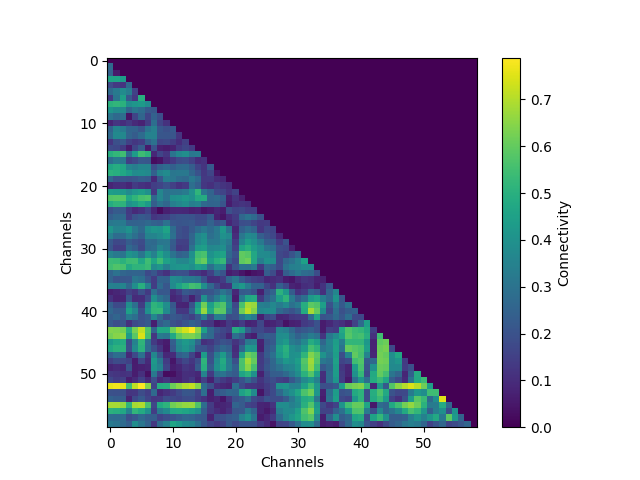
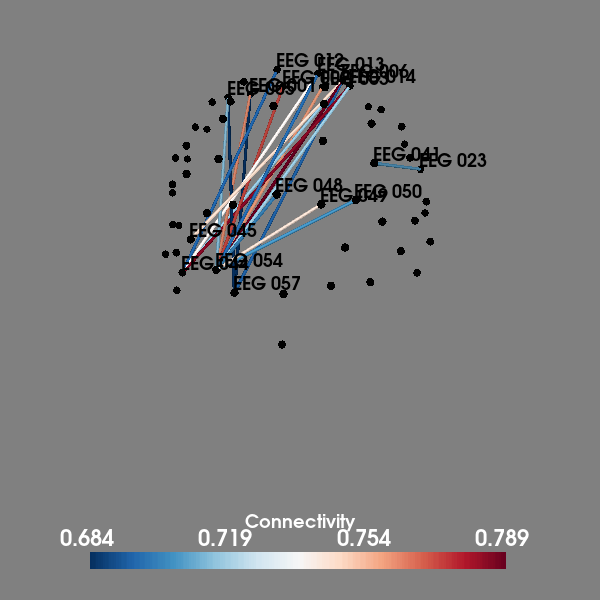
Using pyvistaqt 3d backend.
<mne.viz.backends._pyvista.PyVistaFigure object at 0x70bfac013e00>
Conclusions#
In this example we have looked at the differences between connectivity over
time and connectivity over trials and demonstrated the corresponding
functions implemented in mne_connectivity on simulated data.
Both functions serve their specific roles, and it’s important to use the correct function for the corresponding task to interpret the analysis.
We also briefly analyzed a visual task EEG sample, using
mne_connectivity.spectral_connectivity_epochs() where we found that
there was high global theta connectivity around the timepoint of the P1
evoked response. Further analysis revealed the highest connections
at this timepoint were between occipital and frontal areas.
References#
Total running time of the script: (0 minutes 16.755 seconds)